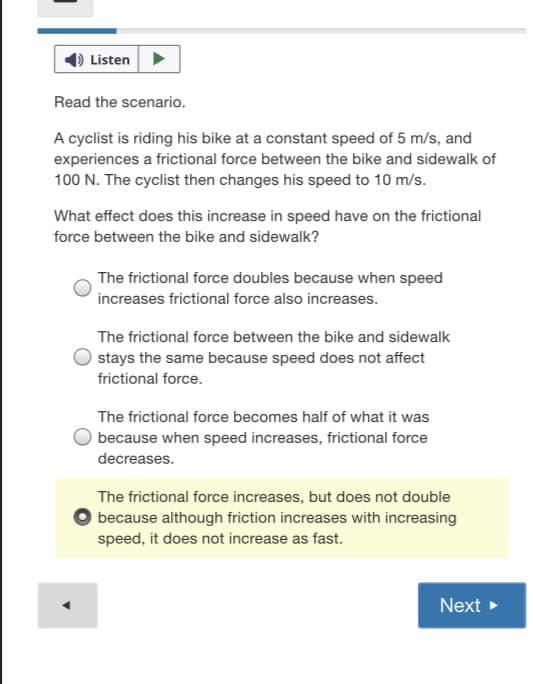Listen> Read the scenario. A cyclist is riding his bike at a constant speed of 5 m/s, and experiences a frictional force between the bike and sidewalk of 100 N. The cyclist then changes his speed to 10 m/s. What effect does this increase in speed have on the frictional force between the bike and sidewalk? The frictional force doubles because when speed increases frictional force also increases. The frictional force between the bike and sidewalk stays the same because speed does not affect frictional force. The frictional force becomes half of what it was because when speed increases, frictional force decreases. The frictional force increases, but does not double because although friction increases with increasing speed, it does not increase as fast. Next
Listen> Read the scenario. A cyclist is riding his bike at a constant speed of 5 m/s, and experiences a frictional force between the bike and sidewalk of 100 N. The cyclist then changes his speed to 10 m/s. What effect does this increase in speed have on the frictional force between the bike and sidewalk? The frictional force doubles because when speed increases frictional force also increases. The frictional force between the bike and sidewalk stays the same because speed does not affect frictional force. The frictional force becomes half of what it was because when speed increases, frictional force decreases. The frictional force increases, but does not double because although friction increases with increasing speed, it does not increase as fast. Next
Principles of Physics: A Calculus-Based Text
5th Edition
ISBN:9781133104261
Author:Raymond A. Serway, John W. Jewett
Publisher:Raymond A. Serway, John W. Jewett
Chapter6: Energy Of A System
Section: Chapter Questions
Problem 13OQ
Related questions
Question

Transcribed Image Text:Listen>
Read the scenario.
A cyclist is riding his bike at a constant speed of 5 m/s, and
experiences a frictional force between the bike and sidewalk of
100 N. The cyclist then changes his speed to 10 m/s.
What effect does this increase in speed have on the frictional
force between the bike and sidewalk?
The frictional force doubles because when speed
increases frictional force also increases.
The frictional force between the bike and sidewalk
stays the same because speed does not affect
frictional force.
The frictional force becomes half of what it was
because when speed increases, frictional force
decreases.
The frictional force increases, but does not double
because although friction increases with increasing
speed, it does not increase as fast.
Next >
Expert Solution
Step 1

Trending now
This is a popular solution!
Step by step
Solved in 2 steps with 2 images

Knowledge Booster
Learn more about
Need a deep-dive on the concept behind this application? Look no further. Learn more about this topic, physics and related others by exploring similar questions and additional content below.Recommended textbooks for you

Principles of Physics: A Calculus-Based Text
Physics
ISBN:
9781133104261
Author:
Raymond A. Serway, John W. Jewett
Publisher:
Cengage Learning

Physics for Scientists and Engineers: Foundations…
Physics
ISBN:
9781133939146
Author:
Katz, Debora M.
Publisher:
Cengage Learning

College Physics
Physics
ISBN:
9781285737027
Author:
Raymond A. Serway, Chris Vuille
Publisher:
Cengage Learning

Principles of Physics: A Calculus-Based Text
Physics
ISBN:
9781133104261
Author:
Raymond A. Serway, John W. Jewett
Publisher:
Cengage Learning

Physics for Scientists and Engineers: Foundations…
Physics
ISBN:
9781133939146
Author:
Katz, Debora M.
Publisher:
Cengage Learning

College Physics
Physics
ISBN:
9781285737027
Author:
Raymond A. Serway, Chris Vuille
Publisher:
Cengage Learning

Physics for Scientists and Engineers, Technology …
Physics
ISBN:
9781305116399
Author:
Raymond A. Serway, John W. Jewett
Publisher:
Cengage Learning

Physics for Scientists and Engineers with Modern …
Physics
ISBN:
9781337553292
Author:
Raymond A. Serway, John W. Jewett
Publisher:
Cengage Learning

Physics for Scientists and Engineers
Physics
ISBN:
9781337553278
Author:
Raymond A. Serway, John W. Jewett
Publisher:
Cengage Learning